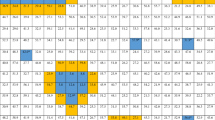Abstract
In many survey situations simple random sampling of units and estimation of a total of interest by the expansion estimator are attractive methods, at least at first sight. Considering cost aspects suggests rather to use multiple stage sampling which, in general, is cheaper, but less effective. The design effect is an adequate criterion of the decrease of efficiency. We discuss this criterion for clusters (primary units) of equal size and derive exact conditions for a decrease of efficiency. The equality condition for cluster sizes seems not to be very restrictive, because in many cases one will be interested in clusters of approximately the same size, or, if sizes differ essentially, the clusters are partitioned into strata according to their sizes and the procedures for different strata are independent, each dealing with clusters of equal size or nearly so. In the context considered the use of the Horvitz–Thompson estimator is quite general. We examine a class of estimators with the Horvitz–Thompson estimator and a straight forward modification of it as special elements. As for the design effect all elements of the class are very similar, as for other aspects such as admissibility there are remarkable differences.
Similar content being viewed by others
References
Fritschi P, Meyer R, Schweizer W (1976) Ein neuer Stichprobenplan für ein gesamtschweizerisches Sample. Schweizerische Zeitschrift für Soziologie 2:149–158
Gabler S (1990) Minimax solutions in sampling from finite populations. Lecture Notes in Statistics. Springer, Berlin Heidelberg New York
Gabler S, Häder S, Lahiri P (1999) A model based justification of Kish’s formula for design effects for weighting and clustering. Surv Methodol 25:105–106
Gabler S, Häder S, Lynn P (2003) Refining the concept and measurement of design effects. ISI-2003 Berlin, 18–20 August 2003
Häder S, Gabler S, Laaksonen S, Lynn P (2003) The sample. Chapter 2 in ESS 2002/2003: Technical Report. http://www.europeansocialsurvey.com
Kish L (1965) Survey sampling. Wiley, New York
Kish L (1995) Methods for design effects. J Official Stat 11:55–77
Lê TN, Verma VK (1997) Demographic and health surveys. Analytical reports No 3: an analysis of sample designs and sampling errors of the demographic and health surveys. Macro International Inc, Calverton, Maryland
Lehtonen R, Pahkinen EJ (1996) Practical methods for design and analysis of complex surveys revised edition. Wiley, New York
Lohr SL (1999) Sampling: design and analysis. Duxbury Press, Pacific Grove
Lynn P, Häder S, Gabler S, Laaksonen S (2004) Methods for achieving equivalence of samples in cross-national surveys: the European social survey experience. ISER Working paper 2004–09
Marshall AW, Olkin I (1979) Inequalities: theory of majorization and its applications. Academic, Orlando
Park I, Lee H (2004) Design effects for the weighted mean and total estimators under complex survey sampling. Surv Methodol 30:183–193
Skinner CJ (1986) Design effects of two-stage sampling. J Roy Stat Soc Ser B 48:89–99
Skinner CJ, Holt D, Smith TMF (eds) (1989) Analysis of complex surveys. Wiley, New York
Stenger H (1979) A minimax approach to randomization and estimation in survey sampling. Ann Stat 7:395–399
Stenger H, Gabler S (1981) On the completeness of the class of fixed size sampling strategies. Ann Stat 9:229–232
Stenger H, Gabler S, Schmidt J (2002) Survey sampling: a linear game.Stat Decis 20:279–295
Verma VK (1982) The estimation and presentation of sampling errors. WFS Technical Bulletins No 11. International Statistical Institute, The Hague
Author information
Authors and Affiliations
Corresponding author
Rights and permissions
About this article
Cite this article
Stenger, H., Gabler, S. Optimal Strategies in 2-Stage Sampling. Metrika 65, 29–42 (2007). https://doi.org/10.1007/s00184-006-0057-8
Received:
Published:
Issue Date:
DOI: https://doi.org/10.1007/s00184-006-0057-8




